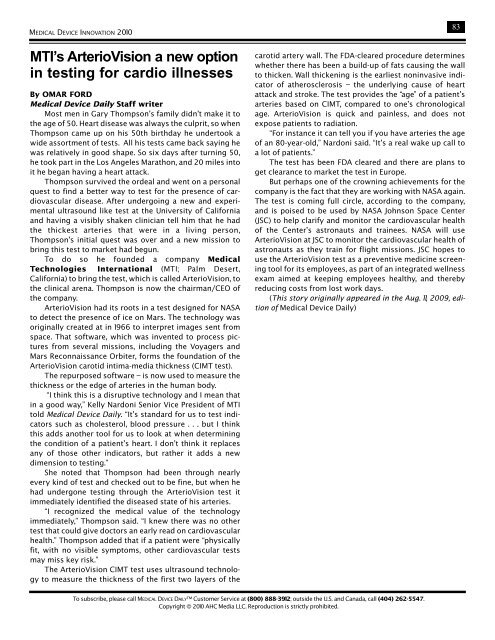MEDICAL DEVICE INNOVATION - Medical Device Daily
MEDICAL DEVICE INNOVATION - Medical Device Daily
MEDICAL DEVICE INNOVATION - Medical Device Daily
You also want an ePaper? Increase the reach of your titles
YUMPU automatically turns print PDFs into web optimized ePapers that Google loves.
<strong>MEDICAL</strong> <strong>DEVICE</strong> <strong>INNOVATION</strong> 2010<br />
MTI’s ArterioVision a new option<br />
in testing for cardio illnesses<br />
By OMAR FORD<br />
<strong>Medical</strong> <strong>Device</strong> <strong>Daily</strong> Staff writer<br />
Most men in Gary Thompson’s family didn’t make it to<br />
the age of 50. Heart disease was always the culprit, so when<br />
Thompson came up on his 50th birthday he undertook a<br />
wide assortment of tests. All his tests came back saying he<br />
was relatively in good shape. So six days after turning 50,<br />
he took part in the Los Angeles Marathon, and 20 miles into<br />
it he began having a heart attack.<br />
Thompson survived the ordeal and went on a personal<br />
quest to find a better way to test for the presence of cardiovascular<br />
disease. After undergoing a new and experimental<br />
ultrasound like test at the University of California<br />
and having a visibly shaken clinician tell him that he had<br />
the thickest arteries that were in a living person,<br />
Thompson’s initial quest was over and a new mission to<br />
bring this test to market had begun.<br />
To do so he founded a company <strong>Medical</strong><br />
Technologies International (MTI; Palm Desert,<br />
California) to bring the test, which is called ArterioVision, to<br />
the clinical arena. Thompson is now the chairman/CEO of<br />
the company.<br />
ArterioVision had its roots in a test designed for NASA<br />
to detect the presence of ice on Mars. The technology was<br />
originally created at in 1966 to interpret images sent from<br />
space. That software, which was invented to process pictures<br />
from several missions, including the Voyagers and<br />
Mars Reconnaissance Orbiter, forms the foundation of the<br />
ArterioVision carotid intima-media thickness (CIMT test).<br />
The repurposed software – is now used to measure the<br />
thickness or the edge of arteries in the human body.<br />
“I think this is a disruptive technology and I mean that<br />
in a good way,” Kelly Nardoni Senior Vice President of MTI<br />
told <strong>Medical</strong> <strong>Device</strong> <strong>Daily</strong>. “It’s standard for us to test indicators<br />
such as cholesterol, blood pressure . . . but I think<br />
this adds another tool for us to look at when determining<br />
the condition of a patient’s heart. I don’t think it replaces<br />
any of those other indicators, but rather it adds a new<br />
dimension to testing.”<br />
She noted that Thompson had been through nearly<br />
every kind of test and checked out to be fine, but when he<br />
had undergone testing through the ArterioVision test it<br />
immediately identified the diseased state of his arteries.<br />
“I recognized the medical value of the technology<br />
immediately,” Thompson said. “I knew there was no other<br />
test that could give doctors an early read on cardiovascular<br />
health.” Thompson added that if a patient were “physically<br />
fit, with no visible symptoms, other cardiovascular tests<br />
may miss key risk.”<br />
The ArterioVision CIMT test uses ultrasound technology<br />
to measure the thickness of the first two layers of the<br />
carotid artery wall. The FDA-cleared procedure determines<br />
whether there has been a build-up of fats causing the wall<br />
to thicken. Wall thickening is the earliest noninvasive indicator<br />
of atherosclerosis – the underlying cause of heart<br />
attack and stroke. The test provides the “age” of a patient’s<br />
arteries based on CIMT, compared to one’s chronological<br />
age. ArterioVision is quick and painless, and does not<br />
expose patients to radiation.<br />
“For instance it can tell you if you have arteries the age<br />
of an 80-year-old,” Nardoni said. “It’s a real wake up call to<br />
a lot of patients.”<br />
The test has been FDA cleared and there are plans to<br />
get clearance to market the test in Europe.<br />
But perhaps one of the crowning achievements for the<br />
company is the fact that they are working with NASA again.<br />
The test is coming full circle, according to the company,<br />
and is poised to be used by NASA Johnson Space Center<br />
(JSC) to help clarify and monitor the cardiovascular health<br />
of the Center’s astronauts and trainees. NASA will use<br />
ArterioVision at JSC to monitor the cardiovascular health of<br />
astronauts as they train for flight missions. JSC hopes to<br />
use the ArterioVision test as a preventive medicine screening<br />
tool for its employees, as part of an integrated wellness<br />
exam aimed at keeping employees healthy, and thereby<br />
reducing costs from lost work days.<br />
(This story originally appeared in the Aug. 11, 2009, edition<br />
of <strong>Medical</strong> <strong>Device</strong> <strong>Daily</strong>)<br />
83<br />
To subscribe, please call <strong>MEDICAL</strong> <strong>DEVICE</strong> DAILY Customer Service at (800) 888-3912; outside the U.S. and Canada, call (404) 262-5547.<br />
Copyright © 2010 AHC Media LLC. Reproduction is strictly prohibited.
















